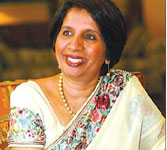The living room of India's ambassador to China showcases not only the beauty of Indian and Chinese art, but also the great harmony between the two civilizations.
(photo: China Daily)
"This is a Chinese tea table," says Nirupama Rao. "Standing on it is a Chinese vase made of porcelain. Above your head is a painting of an Indian goddess, and behind you is an artist's depiction of the Indian mythological character Arjun." Her voice exudes the pride of a curator introducing her favorite pieces in a museum.
"I love to show my collection... Indian and Chinese art go very well together. They blend beautifully. That I think is very symbolic of how well our two civilizations harmonize."
Rao visited China almost 20 times before assuming her present post last November. Like so many people across the world, the Indian ambassador likes to compare China and India, describing them as two ancient "re-emerging civilizations" with more commonalities than differences.
"Since we share similar views on many regional and international matters, we would like to work more closely with our Chinese friends on issues such as the UN reform, the World Trade Organization to safeguard the legitimate interests of developing economies, climate change and in the wider sense, re-structuring the new international order," says Rao whose country is trying to get a permanent seat in the UN Security Council.
Sino-Indian exchanges have developed rapidly in the past few years, especially in the economic field. From less than $3 billion in 2000, bilateral trade crossed $25 billion last year. And this year it has been growing at roughly $3 billion a month to reach $20.49 billion in the first seven months.
"The trade volume is growing by the day. That signifies there are many exchanges between businesspersons, companies and industries of our two countries," Rao says.
Though trade has developed impressively, the growing deficit for India in bilateral trade is a source of some concern, she says.
"Today, India exports mainly raw materials to China, and we have to find ways to diversify the basket of goods."
Increasing familiarization with one another's market and greater exchange of business information and delegations will ensure positive outcomes, too, for bilateral trade, Rao says. As economic exchanges expand, the border between the two countries is becoming a connective link, rather than a dividing line.
Nathu La is such a point along the long border between China and India, where people from both countries can benefit from increased trade. Border trade through Nathu La resumed last year and trade volume during the three months (July to September) reached about $200,000. The two sides are now working to put suitable infrastructure in place to increase border trade.
"We consider border trade between India and China as revalidating very important traditional links."
The other two trade points between the two countries are Lipulekh Pass and Shipki La, which connect southwestern Tibet with the Indian states of Himachal Pradesh and Uttaranchal.
The two governments have just concluded an important round of talks to resolve the long-standing border dispute. Although no concrete decision was reached, the two sides have vowed to find a lasting, fair and reasonable solution to the problem.
The efforts that started with the appointment of the two governments' special representatives to discuss the issue from the political perspective in 2003, seems to be progressing. The discussions led to the signing of the Agreement on Political Parameters and Guiding Principles for the settlement of the India-China Boundary Question in 2005.
Another advantage that China enjoys is tourism, feels Rao. No wonder, she urges more Chinese to go and discover "Incredible India". The disparity in the number of Indian and Chinese tourists is too evident. Last year, more than 400,000 Indians came to China, while the corresponding figure for Chinese visiting India was only about 50,000.
"We would like to see similar growth in the number of Chinese visitors to India. And it is for this reason that the two countries have marked 2007 as the Year of Friendship through Tourism," she says.
Besides rapid economic growth, China and India also share another common factor: a large population. "Though people are a nation's source of strength, the need to provide economically and ecologically sustainable support systems and higher living standards to enable our peoples to flourish is also vital," Rao said.
"China is doing what is the best for the country (by implementing the family planning policy). The population growth rate has come down. That is a very positive achievement," Rao says. But "our approach is different from China's. It is tailored to our situation and requirements," she says, referring to India's Family Welfare Program.
"We are confident that in the decades to come, we too will be able to see a slower population growth," Rao says.
(China Daily October 25, 2007)


